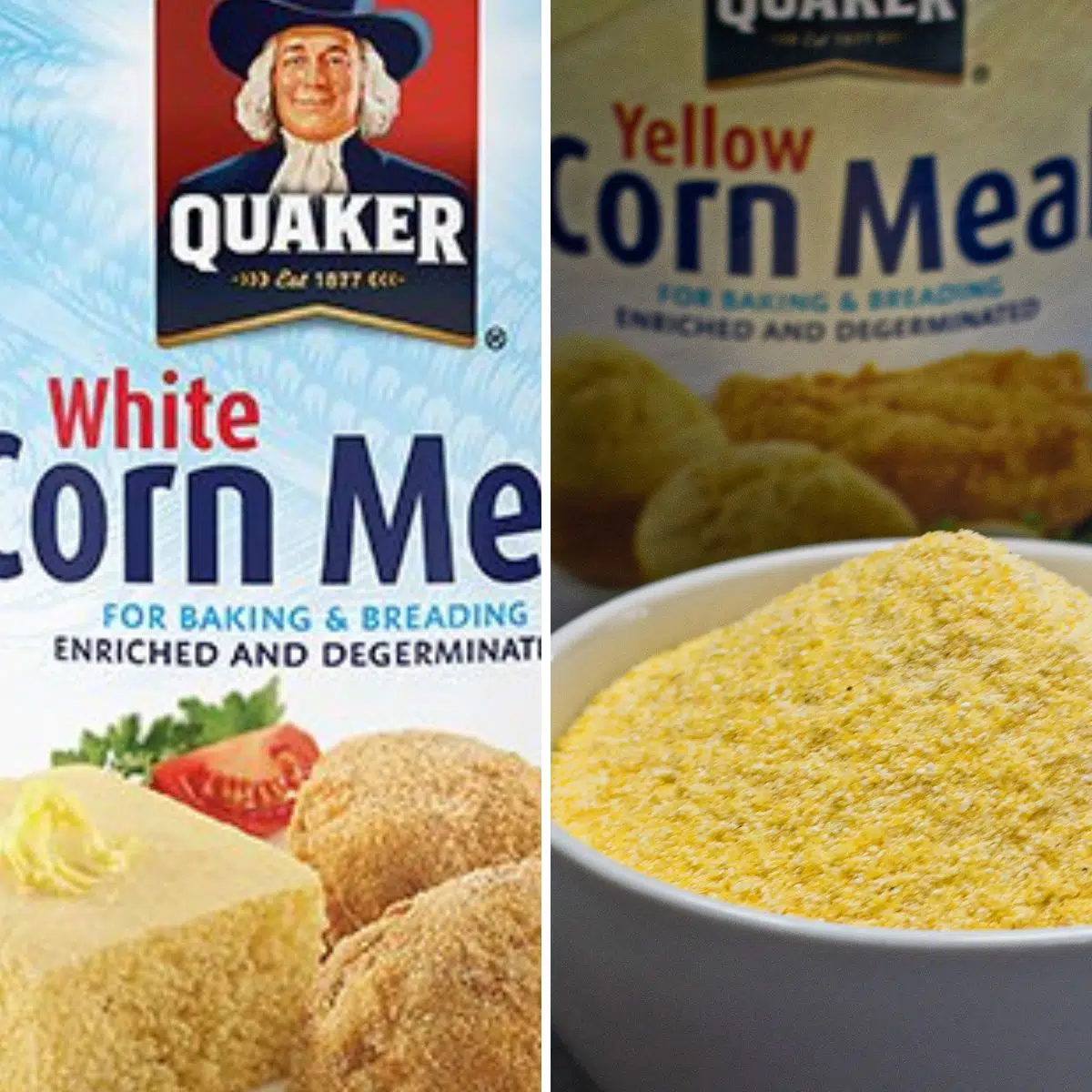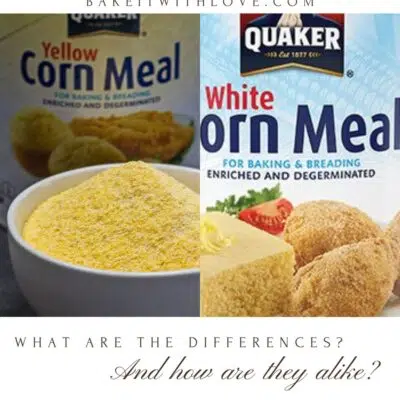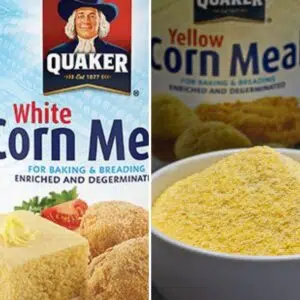Have you asked yourself 'what's the difference between white and yellow cornmeal' and realized you don't know? There are many varieties of cornmeal and their differences could dictate how your recipes turn out! Don't take a gamble, learn everything you need to know about cornmeal right here!
White vs Yellow Cornmeal
You're staring at a packed grocery store shelf with an array of varieties of cornmeal and a recipe with little to no guidance - what is the best type to pick? Well, we're here to help, and below is everything you need to know about white and yellow cornmeal!

Jump to:
- White vs Yellow Cornmeal
- What Is Cornmeal?
- What Is Cornmeal Used For?
- The Different Colors And Types Of Cornmeal
- The Difference Between White And Yellow Cornmeal
- Best Recipes For Each Type Of Cornmeal
- Can I Substitute Cornmeal For Flour?
- Can I Substitute Corn Flour For Corn Starch And Vice Versa?
- 📖 Recipe Card
- 💬 Comments & Reviews
What Is Cornmeal?
First things first: what exactly is cornmeal and what is it used for? Cornmeal put simply, is ground field corn. The meal is the ground cell membrane derived from the dried corn.
To purchase, you find it in the baking aisle (typically) alongside flour and breadcrumbs. It can come in a variety of ground sizes ranging from fine to quite coarse.
Cornmeal will never be as finely ground as traditional wheat flour which is milled and processed differently. The coarseness of the grind actually reflects how long the grain will take to absorb water to become cooked and palatable.
What Is Cornmeal Used For?
Cornmeal is a widely used ingredient across the US. It is commonly used for cakes and bakes; such as muffins, cornbread, and pancakes.
The Different Colors And Types Of Cornmeal
Alongside coming in an array of sizes, cornmeal can also come in an array of colors!
- Blue cornmeal - Cornmeal of this variety has a higher protein content; it is made from dried blue corn rather than the white or yellow varieties. This type of meal, with a sweet and nutty flavor, is great for muffins, cornbread, and pancakes.
- Yellow Cornmeal - Yellow cornmeal, sometimes referred to as 'steel ground' cornmeal. It is referred to this way as yellow cornmeal is processed through a machine that grinds the corn through large metal rollers. This process removes both the husk and the germ so the meal is finer.
- White Cornmeal - This type of cornmeal is derived from dried white corn rather than yellow.
- Stone Ground - Cornmeal that is labeled as 'stone ground' has been processed slightly differently. As the name suggests, this cornmeal has been ground with stone, rather than steel. A large amount of the hull and germ remain. This leads to a coarser product and the cornmeal is less shelf-stable than other varieties so it must be kept cool or even refrigerated to increase the product's longevity.
The Difference Between White And Yellow Cornmeal
The main difference between these two products simply comes down to the color of the corn it was derived from. There are many varieties of corn and some vary slightly in taste. However, these two different types of cornmeal can be used interchangeably within your recipes, with little variation in the outcome and flavor of your recipe.
If you do have both products on hand, yellow corn is known to be sweeter and richer in flavor. Some experts believe that yellow corn has slightly more nutritional value than white.
Yellow corn is said to be healthier because of its levels of beta carotene (better known as vitamin A). That is where the vivid yellow hue comes from.
Best Recipes For Each Type Of Cornmeal
Interestingly, as discussed before - most colors of cornmeal are interchangeable without any negative impact on the outcome of your food. However, what would make a difference is the coarseness of your cornmeal, as this would alter the texture and density of the product.
- Coarse Ground Cornmeal - As the name suggests, you should use coarse cornmeal for any recipe where you would like a more pebble-like texture for the food. Examples include cornbread, crispy pie toppings, or breading for fish and meat.
- Fine or Medium Ground Cornmeal - This type of cornmeal is perfect for muffins, cakes and bakes, pancakes, and also finer and lighter cornbread.
When a recipe does not stipulate which type of cornmeal to use, it is always advisable to go with the finer ground for the most consistent outcome. Unless it's a recipe where you know you would like a grainier texture.
Other Forms of Cornmeal
Grits - Grits are simply coarsely ground white cornmeal. This type of cornmeal is used extensively in Southern recipes. For example, this tasty Southern shrimp and grits.
Polenta - Polenta is made from ground yellow cornmeal that is boiled. It makes a great base for other flavors. Polenta is featured heavily in Mediterranean cooking!
Can I Substitute Cornmeal For Flour?
This is a tricky one. The answer is both yes and no. Cornmeal is derived from field corn and not a wheat product, so it is naturally gluten-free.
However, flour naturally contains gluten which helps keeps baking together making for a delectable, chewy bite. So, should you remove the flour and replace it with cornmeal then the outcome will be crumblier, which would not be appropriate for some baked goods.
A method of mitigating this would be to include a gelling agent, such as Xanthan Gum which acts as a binder in gluten-free baking.
Cornmeal may be used in place of flour for breading, tortillas, muffins, and sturdy loaf cakes. Anything that is required to incorporate more air and rise (like a sponge cake) would not bode well with a substation of cornmeal.
Recipes that would be OK with a little additional density, (like muffins and loaf cakes) would be fine with a sub.
Can I Substitute Corn Flour For Corn Starch And Vice Versa?
You may find these products on the same aisle and area as cornmeal. However, both of these products are slightly different from cornmeal.
Corn starch is, well, 'starchy' while corn flour is a 'protein' flour. That means they carry different reactions when cooked or baked, and as such, do not make good substitutions for one another.
Here are the quick links to some other articles that you might find helpful regarding this topic:
Hopefully, this analysis will help you make an easier decision when selecting cornmeal for your cooking, breading, and baking endeavors! Now you can answer the question: 'What's the difference between white and yellow cornmeal'!
Do you love a recipe you tried? Please leave a 5-star 🌟rating in the recipe card below and/or a review in the comments section further down the page.
Stay in touch with me through social media @ Pinterest, Facebook, Instagram, or Twitter! Subscribe to the newsletter today (no spam, I promise)! Don't forget to tag me when you try one of my recipes!
📖 Recipe Card
What's The Difference Between Yellow & White Corn Meal: Homemade Cornmeal
Ingredients
- 4 cups corn (fresh, frozen, or canned)
- 1 teaspoon salt (optional)
(Note: 2x or 3x only changes the ingredient list)
Instructions
- To dehydrate fresh corn, choose your favorite cooking method and cook for approximately ¾ of the usual cooking time. Your corn should not be completely cooked before dehydrating. Cut the corn from the cob and transfer the kernels to a parchment paper-lined dehydrator tray.To dehydrate frozen corn, simply arrange the frozen kernels on a parchment paper-lined dehydrator tray.*Drained canned corn does not work as well for dehydrating!
- Set your dehydrator to 135ºF (57ºC) and allow both fresh or frozen corn to run between 8-12 hours.
- Check at about the 6-hour mark, break apart any large chunks of corn, and give it a quick shake or flip to help the corn dehydrate evenly.
- The corn is ready when they are firm enough that you can't squeeze them (like popcorn). If you were to hammer a kernel with a meat mallet, it should break rather than turning to mush.
- Process your dehydrated corn or popcorn in a spice grinder, food processor, grain mill, or whatever you have with blades strong enough to do the job. Continue until the cornmeal reaches your desired level of fineness. *Work in batches if needed.
Notes
- Some dehydrators do not have a heat setting. In this case, simply turn the dehydrator on and check the corn about every 3 hours.
- Store your homemade cornmeal in an airtight container in a cool but dry, dark place.



Comments
No Comments